Key Takeaways
- Solar & Hydrogen Revolution: Replacing diesel generators with solar and hydrogen systems can cut emissions by up to 40%, slashing costs and pollution.
- Electric Mining Fleet: Introducing battery-electric or Hydrogen-powered mining trucks eliminates on-site emissions and drastically reduces fuel dependency.
- Waste into Wealth: Recycling mine waste (like tailings and methane gas) into construction materials, fertilizers, and energy turns pollution into profit.
- AI-Powered Emission Tracking: Deploying IoT sensors, satellites, and AI for real-time emission monitoring will revolutionize environmental accountability in mining.
- Green Mining Incentives: Offering tax breaks, loans, and “Green Mining Certifications” will drive both large companies and small-scale miners toward sustainable practices.
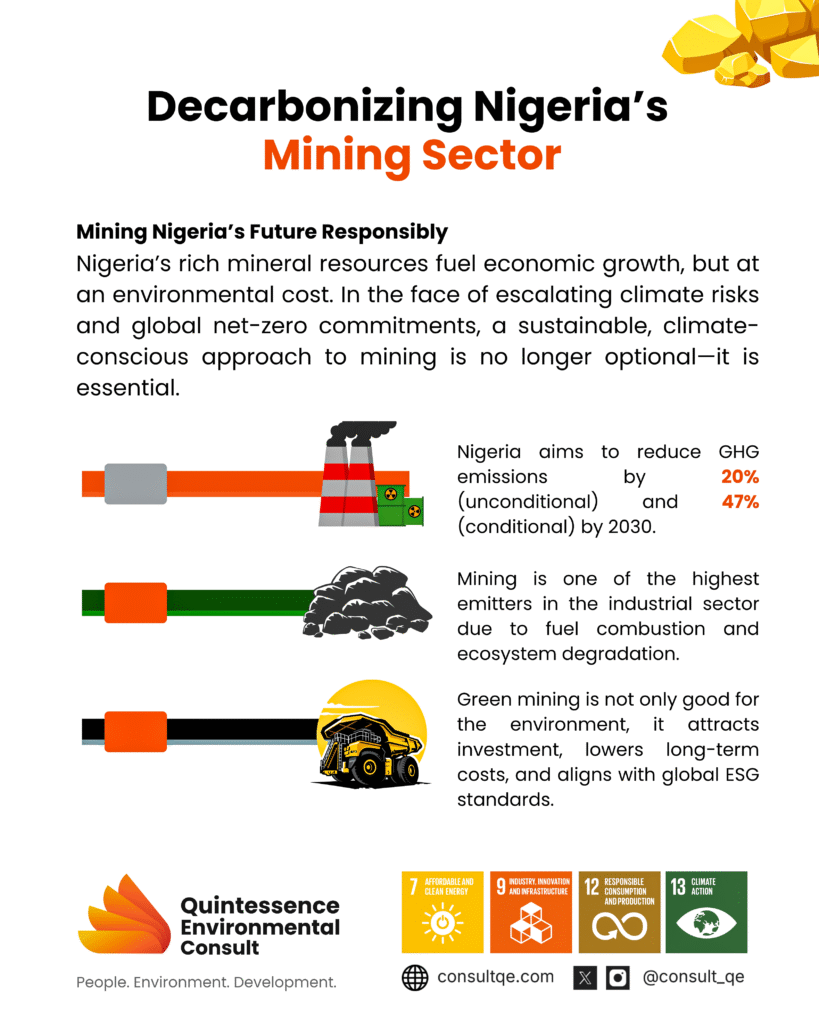
INTRODUCTION
Mining has historically served as a cornerstone of Nigeria’s economic development, with notable resource extraction activities ranging from Tin in Jos and Gold in Zamfara to Lithium in Nasarawa. The country’s substantial endowment of mineral resources presents significant economic opportunities; however, these benefits are accompanied by critical environmental challenges. The mining sector contributes considerably to greenhouse gas emissions, primarily through the combustion of fossil fuels, deforestation, and unsustainable operational practices.
As climate change accelerates and global commitments to net-zero emissions intensify, Nigeria should reassess the environmental implications of its mining activities. Under the Paris Agreement, Nigeria has committed to reducing its GHG emissions by 20% unconditionally and by 47% with international support by 2030, as outlined in its revised Nationally Determined Contributions (NDCs) [1].
This article outlines five key strategies that Nigeria can adopt to decarbonize its mining sector and transition toward a greener, more resilient future.
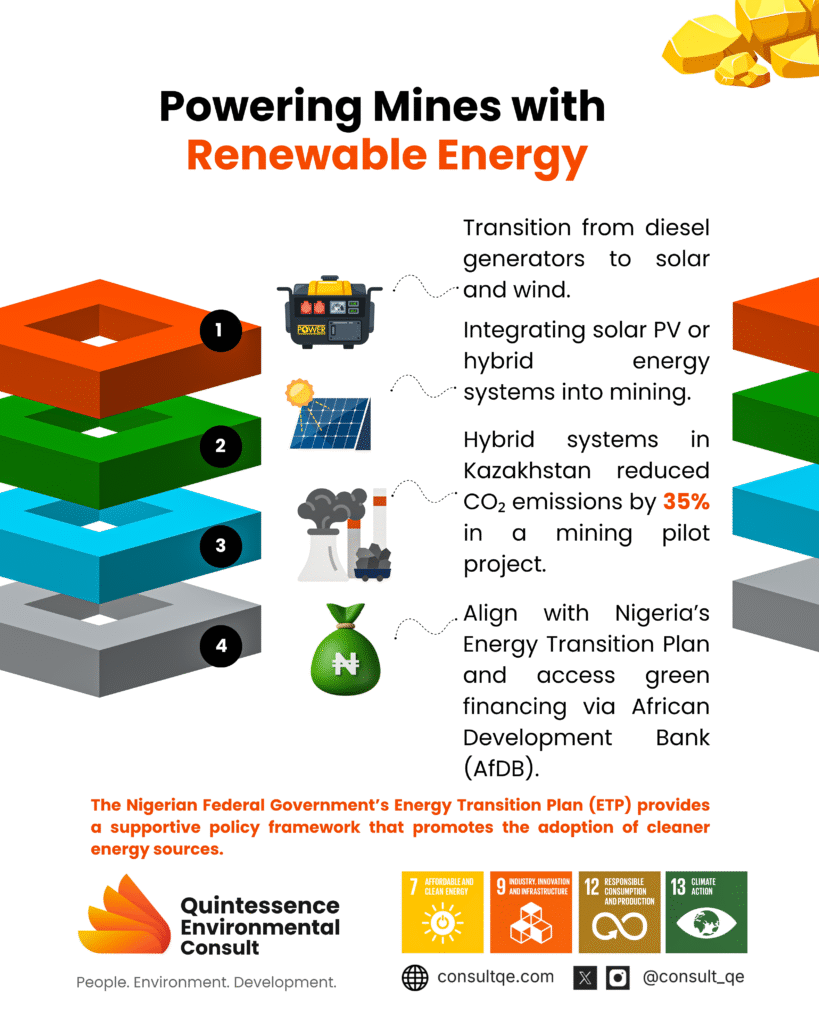
- POWERING MINES WITH RENEWABLE ENERGY
A major contributor to carbon emissions within Nigeria’s mining industry is the reliance on diesel-powered generators, particularly in remote and off-grid locations. These generators are noisy, expensive to run, and highly polluting. The solution lies in transitioning to renewable energy sources such as solar and wind. Nigeria is blessed with abundant sunlight, particularly in the northern regions, making solar photovoltaic (PV) systems a practical and cost-effective alternative.
Hybrid energy systems combining solar PV with battery storage and backup diesel can ensure reliability while significantly reducing emissions. In the Karaganda Power Plant pilot project in Kazakhstan, the integration of Compressed Natural Gas (CNG) and green Hydrogen with diesel resulted in a 30% reduction in CO₂ emissions, a 25% decrease in particulate matter, and up to a 15% reduction in Nitrogen oxides (NOₓ). Moreover, the use of Hydrogen produced through renewable electrolysis contributed to a 40% reduction in overall greenhouse gas emissions. This pilot project also demonstrated up to a 10% improvement in efficiency, showcasing the viability of this hybrid fuel technology for industrial-scale power generation
According to the EKB Journal Management System, a pilot project in Kazakhstan, adopting this approach, reported a 20% improvement in fuel efficiency and a 35% reduction in carbon emissions [2].
The Nigerian Federal Government’s Energy Transition Plan (ETP) provides a supportive policy framework that promotes the adoption of cleaner energy sources. Mining companies can leverage this framework to access green financing options from institutions such as the African Development Bank [3]. Transitioning to renewable energy not only reduces emissions but also lowers operating costs in the long run and enhances the sustainability profile of mining operations. By integrating renewable energy solutions into mining operations, Nigeria can align mineral resource development with long-term environmental sustainability and socio-economic well-being.
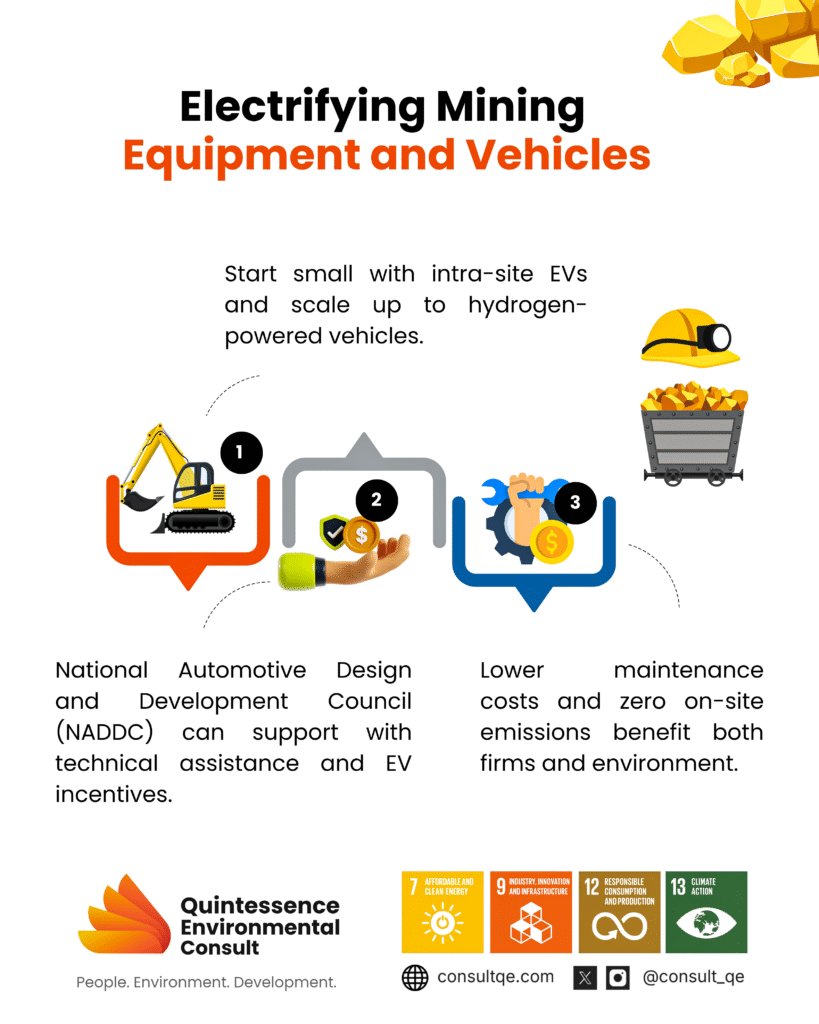
2. ELECTRIFYING MINING EQUIPMENT AND VEHICLES
In Nigeria, the mining sector predominantly relies on diesel-powered machinery such as haul trucks, excavators, and drilling equipment, which contribute significantly to carbon emissions and local air pollution. The adoption of battery-electric or hybrid-powered mining equipment is a forward-thinking solution. These electric machines produce zero on-site emissions and have lower maintenance costs over time.
A global example is Anglo American in South Africa, which deployed the world’s largest hydrogen-powered mining truck at the Mogalakwena platinum mine, demonstrating a strong commitment towards adopting zero-emission equipment in the mining industry [4].
In Nigeria, though still emerging, companies can begin by introducing smaller electric vehicles (EVs) for intra-site transportation. The National Automotive Design and Development Council (NADDC) can play a pivotal role in supporting the adaptation of electric-powered equipment for industrial use by offering incentives and technical assistance.
Electrifying equipment aligns with international ESG (Environmental, Social, and Governance) standards, reduces dependency on imported fossil fuels, lowers operational expenditures, and contributes to Nigeria’s national climate commitments.
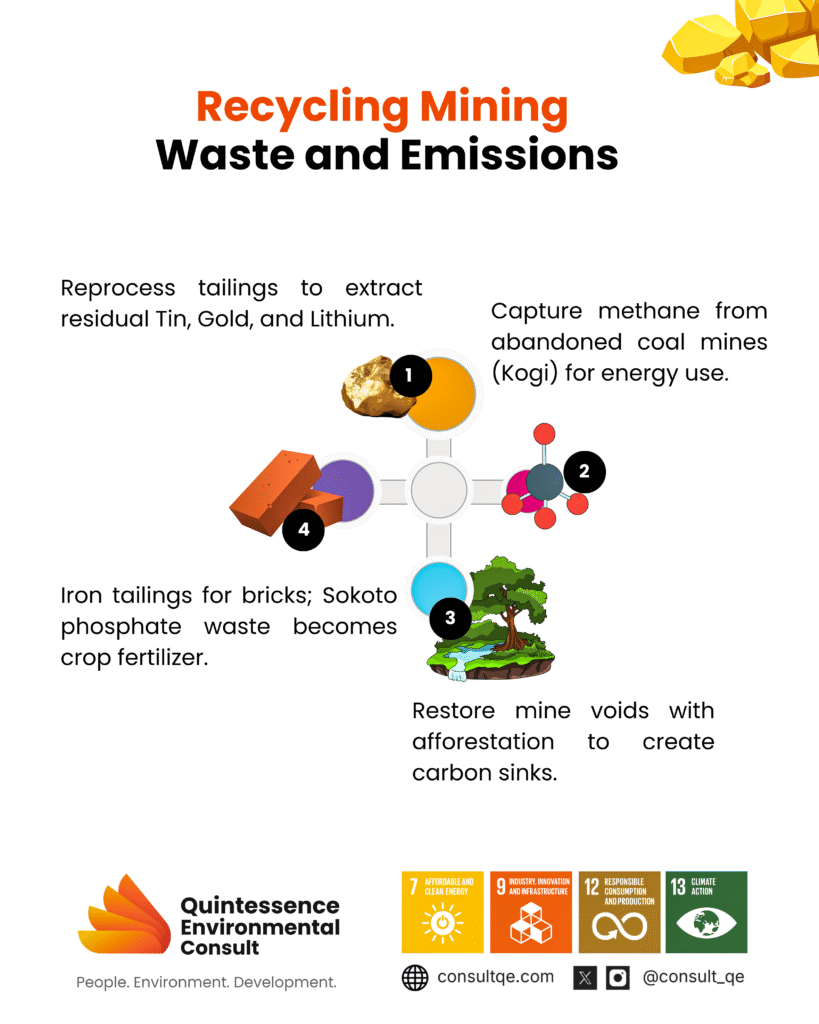
3. RECYCLING MINING WASTE AND EMISSIONS
After minerals are extracted, mining operations leave behind massive amounts of waste materials, such as tailings and overburden. These waste materials often contains sulphide minerals (like Pyrite, FeS₂), when exposed to water and air they undergo oxidation reactions that promote microbial activity (e.g., Iron and Sulfur bacteria), these microbes can produce methane (CH₄) and Carbon dioxide (CO₂) during anaerobic and aerobic processes leading to gas emissions and potential contamination of the surrounding environment if not properly controlled. Embracing circular mining practices, where waste is repurposed into useful products, is a viable strategy to mitigate this impact. Therefore, Nigeria can achieve net-zero emissions in the mining sector by adopting comprehensive recycling of mining waste and emissions. This includes reprocessing tailings from Tin, Gold, and Lithium mines in Plateau, Nasarawa, and Kaduna States to recover residual minerals, thereby reducing the need for fresh extraction and its associated emissions.
Mine waste, such as Iron ore tailings, can be used in construction materials like pavement bricks and cement blocks [5], cutting down on sand quarrying and cement production emissions, while phosphate-rich mining waste in Sokoto can be processed into fertilizers, reducing dependence on imported products.
Additionally, emissions like methane from abandoned coal mines in Kogi can be captured for local power generation or cooking gas, and carbon dioxide from mining operations can be trapped for industrial use, such as in beverage carbonation or enhanced oil recovery. Recycling old mining equipment through metal recovery in industrial hubs like Kano and Lagos also lowers the carbon footprint of steel production.
Furthermore, mine voids can be filled with inert waste materials and rehabilitated through afforestation, turning degraded lands into carbon sinks, while powering recycling facilities with solar or hydropower in locations like Sokoto and Jos, eliminating fossil fuel dependence. Together, these measures position Nigeria’s mining sector on a viable path to achieving net-zero emissions while fostering sustainable economic growth.
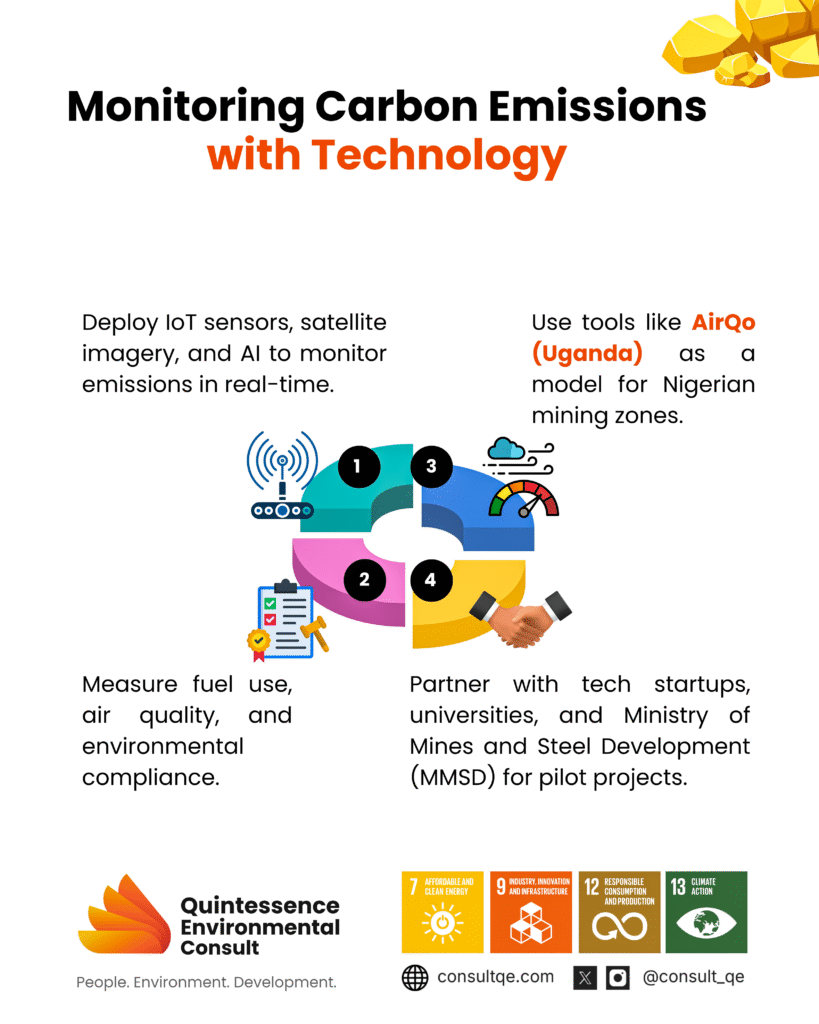
4. MONITORING CARBON EMISSIONS WITH TECHNOLOGY
An essential step in managing carbon emissions is accurate measurement. Unfortunately, most mining companies in Nigeria currently do not track their carbon footprints, making it difficult to implement effective reduction strategies.
The use of digital tools such as Internet of Things (IoT) sensors, satellite imagery, and artificial intelligence (AI) platforms can help track emissions, fuel usage, air quality, and compliance with environmental standards. In Uganda, for instance, the AirQo project employs low-cost air quality sensors and AI to monitor pollution in real-time. A similar framework can be introduced in Nigerian mining zones [6].
By initiating partnerships between the Ministry of Mines and Steel Development, local tech startups, and academic institutions, Nigeria can pilot emission monitoring systems across major mining clusters. These initiatives will not only improve transparency and accountability but also enable companies to report their environmental performance to regulators, investors, and the public.
Ultimately, data-driven monitoring builds trust, supports regulatory compliance, and guides decision-making toward sustainability.
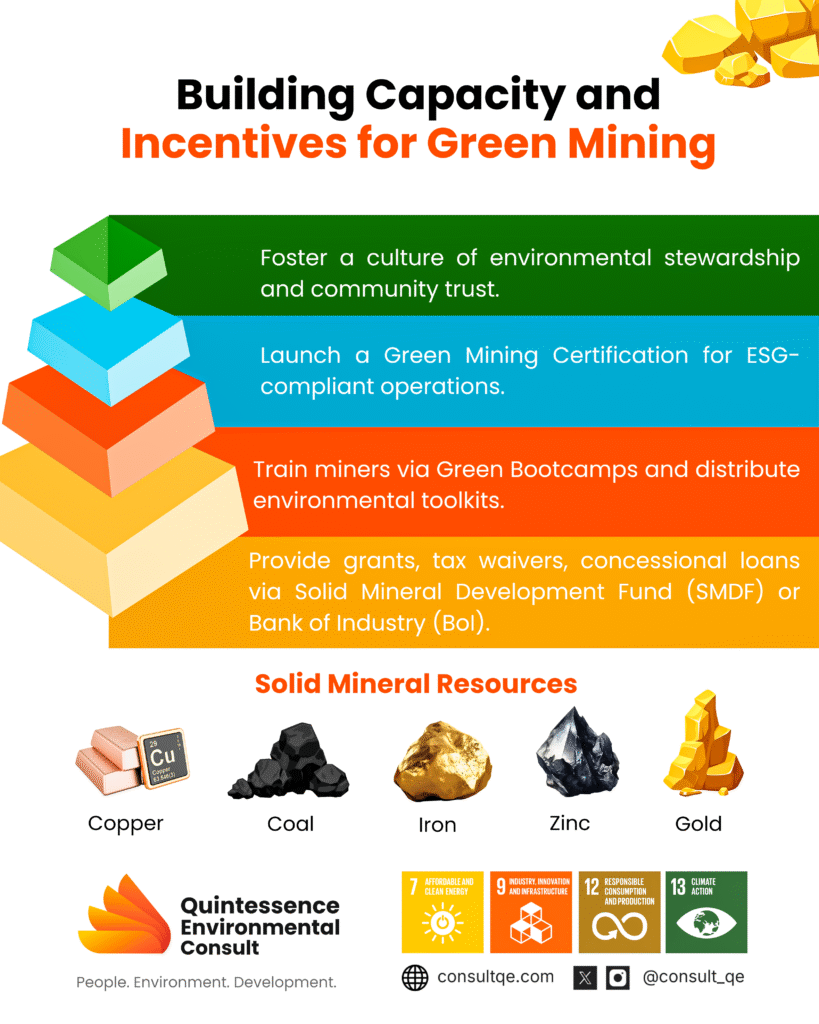
5. BUILDING CAPACITY AND INCENTIVES FOR GREEN MINING
Many artisanal and small-scale miners (ASMs) in Nigeria operate with limited knowledge of environmentally friendly practices. Likewise, larger companies often lack sufficient incentives to adopt greener technologies. Addressing this challenge requires both education and financial support.
Capacity-building programs, such as “Green Bootcamps,” technical workshops, and the distribution of environmental management toolkits, can raise awareness and equip miners with sustainable skills. Additionally, introducing a Green Mining Certification program can recognize and reward companies that demonstrate environmental responsibility [7].
To make green investments attractive, agencies like the Solid Minerals Development Fund (SMDF), UNDP, and the Bank of Industry can offer grants, tax waivers, or concessional loans to support companies in adopting low-carbon technologies and practices.
This dual approach, “capacity building and financial incentives,” empowers both small-scale and large-scale miners to transition toward environmentally responsible operations. It also strengthens community trust and fosters a culture of environmental stewardship.
6. POLICY ENABLEMENT AND PRIVATE SECTOR COMPLIANCE
Achieving net-zero in Nigeria’s mining sector requires more than just technology, it demands a strong policy backbone and full participation from the private sector, which dominates mining activities. Government must set the tone through enforceable regulations that mandate emission tracking, energy disclosure, and phased adoption of cleaner technologies.
At the same time, the private sector must be incentivized to act. Policy tools like tax credits for renewable energy investments, import duty waivers on clean technologies, concessional green loans, and guaranteed offtake schemes for solar energy can lower the financial barriers. A “Green Mining Certification” system would reward compliant operators while building investor confidence.
Public-private partnerships and targeted capacity building will further accelerate this shift. With the right policy signals and support, Nigeria’s mining sector can become both profitable and environmentally responsible.
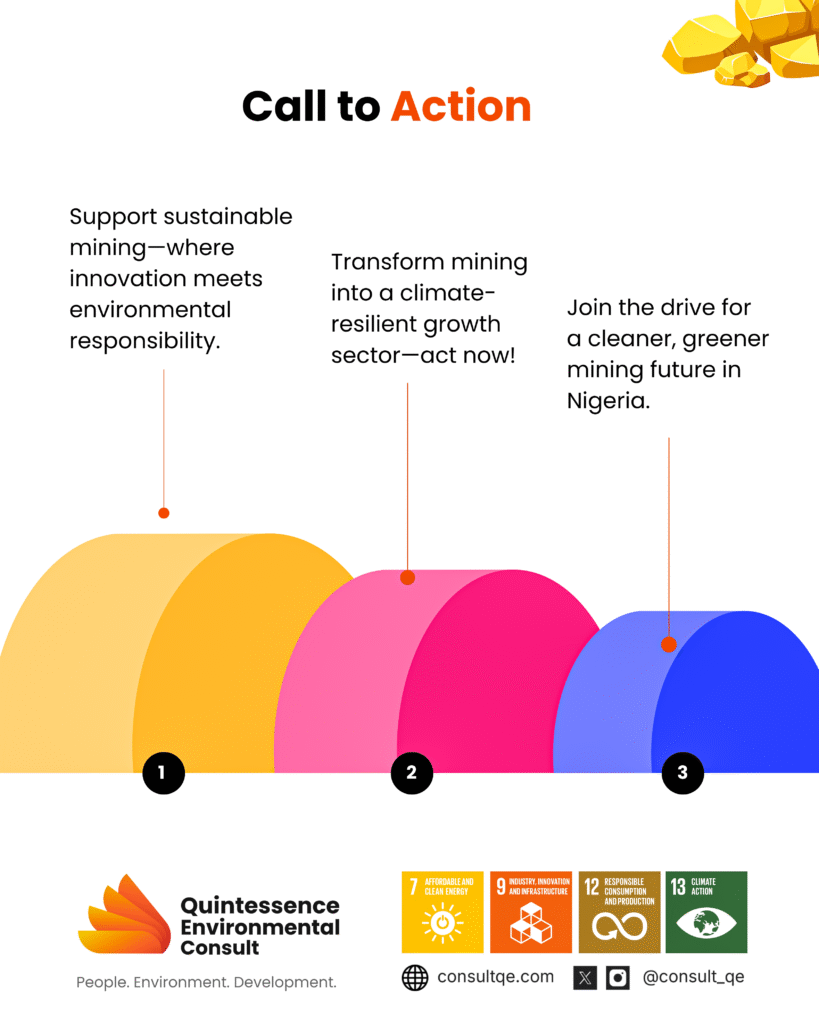
CONCLUSION: TOWARD A NET-ZERO MINING FUTURE IN NIGERIA
Decarbonizing Nigeria’s mining sector is no longer a matter of choice; it’s a necessity. As the world moves towards a low-carbon future, Nigeria has the opportunity to lead in Africa by building a resilient and environmentally sustainable mining industry. Achieving this transformation requires the integration of renewable energy sources, electrification of mining operations, effective mine-waste recycling systems, robust emissions monitoring, and comprehensive capacity-building initiatives. Collectively, we can mine our natural resources without compromising the health of our planet.
- https://ndcpartnership.org /country/nga#:~:text=Nigeria%20 submitted% 20its%20first% 20NDC,achieve%20net% 2Dzero%20by%202060.
- Elkelawy, M., Draz, A. M., Antar, A. M., & Seleem, H. E. (2025). Enhancing Diesel Generator Efficiency and Emissions with CNG and Green Hydrogen: A Sustainable Solution for Power Plants. Pharos Engineering Science Journal, 2(1), 47-57.
- https://www.afdb.org/en/news-and-events/press-releases/african-development-bank-group-approves-500-million-loan-boost-electricity-access-nigeria-73123?utm_source=chatgpt.com
- https://www.angloamerican.com /media/press-releases/2022/06-05- 2022#:~:text=Back%20to%202022-, Anglo%20American%20unveils% 20a% 20prototype%20of%20the% 20world’s%20largest%20hydrogen, produced% 20at%20the% 20mine%20site.
- Sá, T. S. W., Oda, S., Machado, V. K. C. B. L., & Toledo Filho, R. D. (2022). Use of iron ore tailings and sediments on pavement structure. Construction and Building Materials, 342, 128072.
- https://www.weforum.org/ stories/2022/06/ugandan-researchers- low-cost-sensors-air-pollution/? utm_source=chatgpt.com
- https://greenbootcamps.com/en/
- https://www.mining-outlook.com/sustainability/
harnessing-electrification-to-reduce-minings-carbon-footprint?utm_source=chatgpt.com
